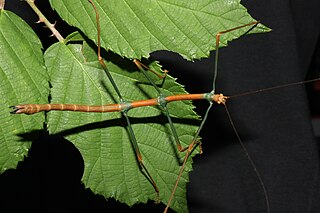
Carausius is a genus of the tribe Lonchodini, in the order Phasmatodea. The genus is in many ways typical of the Phasmatodea in that all species are twig-like in appearance. These species are parthenogenetic.
Mnesilochus is a genus of stick insects in the subfamily Lonchodinae. Species have a known distribution in: Borneo, Philippines, Sumatra.

Necrosciinae is a subfamily of the stick insect family Lonchodidae, with its greatest diversity in South-East Asia.

Lonchodes is a genus of stick insects in the family Phasmatidae and the type genus of the family Lonchodidae and tribe Lonchodini. Species have a known distribution that includes tropical Asia and the Pacific.

Ramulus is an Asian genus of stick insects in the family Phasmatidae and tribe Clitumnini.
Paraprisomera coronata, is a species of phasmid or stick insect of the genus Paraprisomera. It is found in Sri Lanka.
Cuniculina obnoxia, is a species of phasmid or stick insect of the genus Cuniculina. It is found in Sri Lanka.
Prisomera ignava is a species of phasmid or stick insect of the genus Prisomera. It is found in Sri Lanka.
Prisomera spinosissimum is a species of phasmid or stick insect of the genus Prisomera. It is found in India, Sri Lanka and Malaysia.

The Clitumninae are a sub-family of stick insects in the family Phasmatidae found in Asia. The type genus Clitumnus is now considered a synonym of Ramulus.

Medauroidea is an Asian genus of stick insects in the family Phasmatidae and subfamily Clitumninae. Species have been recorded from Indo-China.
Medauromorpha is an Asian genus of stick insects in the family Phasmatidae, subfamily Clitumninae and tribe Medaurini. Species have a known distribution from Vietnam and southern China.

The Gratidiini are a tribe of stick insects based on the type genus Clonaria and first used by Cliquennois in 2005. Genera are known to be distributed in: Africa, Europe, temperate and tropical Asia and various Pacific Islands.

The Platycraninae are an anareolate subfamily of stick insects in the family Phasmatidae. Their known distribution includes southern, southeast Asia and Australasia.
Pachymorpha is a genus of phasmids belonging to the family Diapheromeridae.

The Cladomorphinae are a subfamily of stick insects in the family Phasmatidae. This taxon is particularly well represented in the Neotropical region, but records also exist for Madagascar, Java and the Maluku Islands.
Nesiophasma is a genus of very large stick insects within the order Phasmatodea and the tribe of Stephanacridini. Known species occur in Sulawesi, Selayar Island south of Sulawesi, Sangir Island, Lesser Sunda Islands, and New Guinea. The largest in the list of species is Nesiophasma giganteum, with females reaching a body length of 30 cm.
Metentoria is a genus of stick insects in the tribe Clitumnini, erected by Carl Brunner von Wattenwyl in 1907. Species have been recorded from: India and Vietnam.
Prosentoria is a genus of stick insects in the tribe Clitumnini, erected by Carl Brunner von Wattenwyl in 1907. Species have been recorded from: Vietnam and Borneo.
Spinoparapachymorpha is a genus of stick insects in the tribe Medaurini, erected by G.W.C. Ho in 2021. Species have been recorded from: China, Laos, Myanmar, Thailand and Vietnam.








